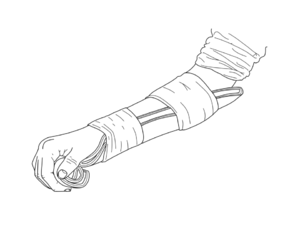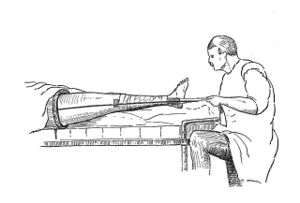Splinting: Difference between revisions
No edit summary |
No edit summary |
||
| Line 88: | Line 88: | ||
== Side Effects of Splinting == | == Side Effects of Splinting == | ||
Arthrofibrosis (ie, scar tissue complicates an injury or trauma) | * Arthrofibrosis (ie, scar tissue complicates an injury or trauma) | ||
* Excessive use of splints can lead to stiff joints or weak muscles. | |||
Excessive use of splints can lead to stiff joints or weak muscles. | * Skin irritation<ref>Johnston JJ, Spelman L. [https://pubmed.ncbi.nlm.nih.gov/27613591/ Pressure-induced localised granuloma annulare following use of an elbow splint]. Prosthetics and orthotics international. 2017 Jun;41(3):311-3.</ref> | ||
* Discomfort<ref>So H, Chung VC, Cheng JC, Yip RM. [https://onlinelibrary.wiley.com/doi/full/10.1111/1756-185X.13162 Local steroid injection versus wrist splinting for carpal tunnel syndrome: a randomized clinical trial]. International Journal of Rheumatic Diseases. 2018 Jan;21(1):102-7.</ref> | |||
Skin irritation<ref>Johnston JJ, Spelman L. [https://pubmed.ncbi.nlm.nih.gov/27613591/ Pressure-induced localised granuloma annulare following use of an elbow splint]. Prosthetics and orthotics international. 2017 Jun;41(3):311-3.</ref> | |||
Discomfort<ref>So H, Chung VC, Cheng JC, Yip RM. [https://onlinelibrary.wiley.com/doi/full/10.1111/1756-185X.13162 Local steroid injection versus wrist splinting for carpal tunnel syndrome: a randomized clinical trial]. International Journal of Rheumatic Diseases. 2018 Jan;21(1):102-7.</ref> | |||
== References == | == References == | ||
Revision as of 17:44, 29 October 2020
This article is currently under construction and may only be partially complete. Please come back soon to see the finished work. Thank you! (29/10/2020)
Original Editor - Shwe Shwe U Marma
Top Contributors - {{Special:Contributors/Template:Splint}}
Definition[edit | edit source]
A splint is a rigid or flexible device that maintains in position a displaced or movable part, also used to keep in place and protect an injured part[1] to support healing, and to prevent further damage[2].
Purpose or indications of Splinting[edit | edit source]
- Immobilization
- Support to promote healing
- Positioning or supporting during function
- Pain relief[3]
- Correction and prevention of deformity[4]
- Restoring or maintaining of range of motion[5]
- Oedema control[6]
Different Types of Splints[edit | edit source]
Splints for Upper Extrimity[3][edit | edit source]
| Region | Type of splint |
|---|---|
| Ulnar side of hand | Ulnar gutter splint |
| Radial side of hand | Radial gutter splint |
| Thumb, first metacarpal, and carpal bones | Thumb spica splint |
| Finger injuries |
|
| Wrist/hand |
|
| Forearm | Single sugar-tong splint |
| Elbow, proximal forearm, and skeletally immature wrist injuries |
|
Splints for Lower Extrimity[3][edit | edit source]
| Region | Type of splint |
|---|---|
| Ankle |
|
| Lower leg, ankle and foot | Short leg cast |
| Knee and lower leg | Posterior knee splint |
| Foot | Short leg cast with toe plate extension |
Contraindications of Splinting[edit | edit source]
No specific contraindications to splinting exist. However, certain injuries and patient-specific comorbidities require special attention:
- Injuries that violate the skin or open wounds: Antibiotic administration should be considered for these patients depending on the severity of the lesion. These patients also require additional soft tissue care, which may necessitate tissue debridement and skin closure before splint application.
- Injuries that result in sensory or neurologic deficits: The complications of splint placement such as compartment syndrome, pressure injuries, or malreduction may go unnoticed if the patient has a concurrent nerve injury. These patients should undergo evaluation by a surgeon before splint application as neurologic findings may be a sign of a surgical emergency.
- Injuries to the vasculature: This require special attention by vascular surgeons, as these may require urgent operative intervention. Furthermore, evaluation of the vasculature is essential both before and after splint application, as the reduction of some fractures may result in acute arterial injury or obstruction if trapped between the fracture fragments.
- Patients with peripheral vascular disease or neuropathy: Special care should be taken when applying lower extremity splints in these patients since their baseline sensation may be altered. These patients have difficulty detecting pressure sores, skin irritation, and possible vascular compromise.[2]
Side Effects of Splinting[edit | edit source]
- Arthrofibrosis (ie, scar tissue complicates an injury or trauma)
- Excessive use of splints can lead to stiff joints or weak muscles.
- Skin irritation[7]
- Discomfort[8]
References[edit | edit source]
- ↑ VanBlarcom CW, editor. The glossary of prosthodontic terms. Mosby; 1999.
- ↑ 2.0 2.1 Althoff AD, Reeves RA. Splinting. StatPearls [Internet]. 2020 May 24.
- ↑ 3.0 3.1 3.2 Boyd AS, Benjamin HJ, Asplund CA. Splints and casts: indications and methods. American family physician. 2009 Sep 1;80(5):491-9.
- ↑ Singh KA, Shah H, Joseph B. Comparison of plaster-of-Paris casts and Woodcast splints for immobilization of the limb during serial manipulation and casting for idiopathic clubfoot in infants: a prospective randomized trial. The Bone & Joint Journal. 2020 Oct 3;102(10):1399-404.
- ↑ Rezaei B, Mahdavinejad R. Massage therapy and Splint in males with Carpal Tunnel syndrome. Journal of Advanced Pharmacy Education & Research| Jan-Mar. 2020;10(S1).
- ↑ Giang TA, Ong AW, Krishnamurthy K, Fong KN. Rehabilitation interventions for poststroke hand oedema: a systematic review. Hong Kong Journal of Occupational Therapy. 2016 Jun 1;27:7-17.
- ↑ Johnston JJ, Spelman L. Pressure-induced localised granuloma annulare following use of an elbow splint. Prosthetics and orthotics international. 2017 Jun;41(3):311-3.
- ↑ So H, Chung VC, Cheng JC, Yip RM. Local steroid injection versus wrist splinting for carpal tunnel syndrome: a randomized clinical trial. International Journal of Rheumatic Diseases. 2018 Jan;21(1):102-7.








